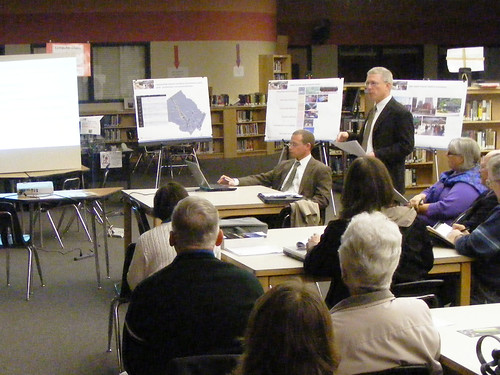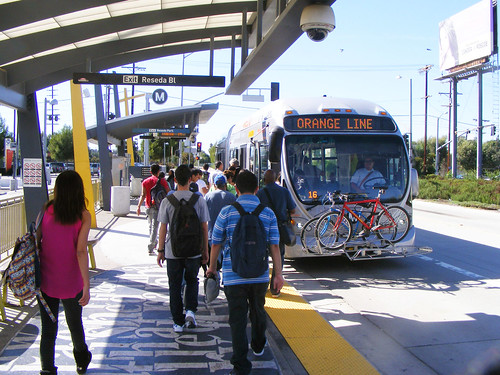 |
| Transportation planner Larry Cole gives a presentation on his BRT proposal. |
Montgomery County planners are making the case for a countywide bus rapid transit network, saying it will reduce commute times and help absorb population growth. But at an open house Tuesday night at Blair High School in Four Corners, residents questioned the merits of BRT and whether it justified giving up car lanes.
Last week, Planning Department staff released their recommendations for a 10-line, 92-mile network of rapid bus routes across the county. The system, which may not be finished until 2040, would feature substantial stations with waiting areas and fare machines, stops spaced between a half-mile and a mile apart, and have frequent service throughout the day.
Planners focused on what they saw as the most successful places for transit, namely congested roads in the downcounty and along the developing I-270 corridor. They also emphasized giving buses their own dedicated lanes, whether in the median of a road or on the curb. Not only did they find that this would reduce travel times, but that it could help the county absorb the 200,000 additional residents who will live here in 30 years.
Ongoing development in places like White Flint and proposed development like the White Oak Science Gateway is designed to encourage transit use, and without more transit, they will be a greater burden on the road network.
View Larger Map
There wasn't any outright opposition to the plans, but residents clearly weren't convinced of the merits of BRT. Some struggled to understand what made BRT different from Metrobus or Ride On. "BRT is like a starry-eyed concept . . . but I keep looking for a purpose," said Harold McDougall, a law professor who lives in Four Corners. "Once you come through a community like this, you have to have answers."
Much of the discussion revolved around Route 29, which backs up for miles at rush hour with drivers heading towards the Beltway and the District. North of New Hampshire Avenue, Route 29 has a wide median where buses could run, but south of New Hampshire, the road is hemmed in by houses and shopping centers with no room to expand. Residents asked why it was necessary to take away lanes from cars on an already congested road, and questioned why improvements to existing service, like more frequent buses and safer waiting areas, wouldn't suffice.
Cole noted that their traffic models showed that a bus lane could carry far more people. "We will have more bus riders than cars we can move," he noted.
A few residents felt that the plan was a step in the right direction. "You can't assume that the current model of everyone driving is sustainable" as the county grows, said one resident who refused to be quoted by name.
 |
| Traffic on Route 29 already backs up for several miles during rush hour. |
Nevertheless, it's not surprising that people are skeptical. There are very few examples of BRT in North America, and many people in Montgomery County aren't familiar with it. They want to know how the service will look in their neighborhoods, including where stops would go and how bus lanes would interact with cars, pedestrians and bicyclists. And they're frustrated that four years since County Councilmember Marc Elrich first introduced the idea of a countywide BRT system, those details aren't yet available.
As a result, the burden is on the Planning Department, the Department of Transportation and other related agencies to make a case for BRT. While they aren't yet studying the system at the level of detail many residents want, it's important to make this concept as clear and compelling as possible.
For starters, county planners need to show how BRT can help neighborhoods like Four Corners where residents already take the bus. Jim Zepp, Four Corners resident and member of the Montgomery County Civic Federation, argued that the BRT system would benefit long-distance commuters from "Howard County and Burtonsville" while buses passed over closer-in neighborhoods south of New Hampshire Avenue.
However, those communities still benefit if residents living further out choose to take BRT instead of driving through their neighborhood. And even if stop locations won't be finalized for a long time, planners should stress that BRT will serve closer-in neighborhoods as well. After all, whether your bus trip is 10 miles or 3 miles long, having faster bus service means a shorter trip for everyone.
 |
| A BRT station in Los Angeles. |
Either way, bus rapid transit may not come to Montgomery County for a long time, especially with recent comments from County Executive Ike Leggett that there's no money for new transit. Cole noted that individual features of the system, like more frequent buses or limited-stop routes, could give commuters some of the benefits of BRT right away, hopefully making them more receptive to future changes.
In fact, Montgomery County will see its first experiment with BRT later this year. At the meeting, Gary Erenrich of the Montgomery County Department of Transportation announced that WMATA will introduce a frequent, limited-stop bus route along New Hampshire Avenue, the MetroExtra K9, at the end of December.
Cole stressed that not doing anything wasn't a solution for congestion or projected population growth. "The traffic is going to be bad anyway," he said. "The question is whether there will be improved service."
There will be one additional open houses this week, tonight at the Shady Grove Training Center in Rockville and tomorrow at the Wheaton Library. Both meetings will start at 6:30pm with a brief presentation at 7pm.
Planners will take comments at each open house and incorporate them into a draft of the Countywide Transit Corridors Functional Master Plan, which will set aside space for future transit lines. If the Planning Board votes to approve the plan in January, it will then go for a vote at the County Council later next year.

4 comments:
Woody Brosnan wrote,
While that meeting was going on the stakeholders group for the Georgia Avenue study was being shown the state highway department concepts for Georgia Avenue between 16th St. and Forest Glen Road.
The concepts included one option for dedicated BRT lanes, northbound and southbound. One of the casualties of that concept is a median down Georgia that would make it safer for residents to cross Georgia and help make Montgomery Hills a walkable community. As I've said before, no one has yet to make a case why a Georgia Avenue BRT route needs to extend past the metro stations at Glenmont or Wheaton.The purpose of BRT should be to get commuters to Metro lines, not compete with Metro.
Woody,
All transit isn't created alike, and different services don't automatically compete with each other. Think of Metro as an "express" service: in Montgomery County, the stops are far apart (about two miles). Metrobus and Ride On are "local" service, with stops every block or couple of blocks. BRT goes in the middle - the stops as proposed in the BRT report along Georgia Avenue are about a half-mile apart, meaning it can serve the places that currently are too far to walk to a Metro station, but at a faster pace than the current local service.
Our friend Jarrett Walker has a nice explanation of the difference between the three services. They can and do compliment each other. Whether or not that makes sense in Montgomery Hills is up for debate (I think it does, and I think you can get your median, too).
If that doesn't answer your question, Woody, let me know.
Dear Dan.
I do understand the differences between the three services.
I also understand that all these things involve tradeoffs and all cost the taxpayers hard-earned money.
It is time to get realistic about what we can afford to set priorities.
My neighborhood also is do to be served by the Purple Line. Do we really need Red Line, Purple Line, Brt, Ride On and Metro bus stops all within a mile of each other?
Woody,
You could say the same thing about roads, or schools, or any other public amenity. Just because you personally may not use any of the services you mentioned doesn't meant they aren't useful to someone else. Besides, how much time and money do people lose sitting in traffic? Not doing anything might feel like it's saving money, but in the long run, it's not a viable solution.
Everything costs money, and yes, we need to set priorities. But it's also wise to look at what our transportation needs will be in the future - and it turns out they may involve all of the things you mentioned. Obviously, they're not all going to be built tomorrow. But Montgomery County cannot and will not grow and continue to prosper if we try to accommodate everyone driving, and we must give people real alternatives.
Post a Comment